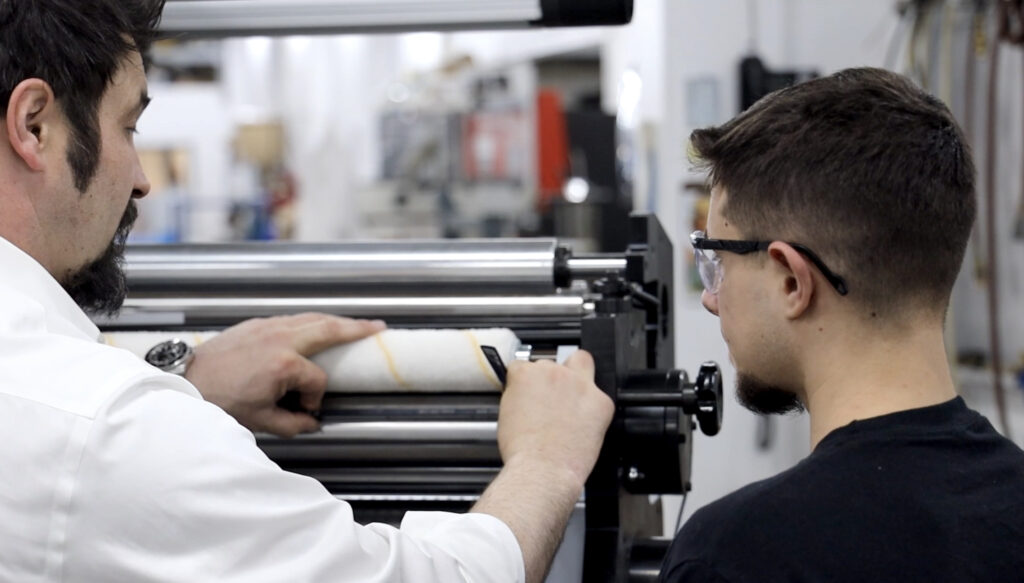Flexographic printing plates are used during the flexible printing process, which involves printing on a type of roll-fed flexible substrate and is commonly used for large print volumes such as making labels and packaging. Flexo printing allows for printing on different types of substrates such as papers and films at high speeds up to 2000 ft./m. Many products are made with flexographic printing presses, such as gift wrap, plastic bags, plates, folding cartons, and many other printable products. You can learn more about how flexographic printing works, and read on to learn more about choosing the best type of flexo plate for your process.
How to Choose The Perfect Flexo Plate
The flexo plate is what transfers the ink and images to your substrate. Answering some questions about your process will help you to choose the best type of flexo plate for your printing application. You will want to ask yourself if you are simply looking for the lowest cost plate or if you want the best possible image quality. Are you going to print images with highlights or solidly filled areas? Considering specific metrics for your application will help you to choose the best type of flexo plate for your application.
Some of the most important metrics include:
-
- Plate hardness
-
- Line screen level
-
- Flat top dots
-
- Micro screening plate
-
- Plate duration
-
- Plate surface screening
Plate Hardness
The durometer, or hardness of the plate, impacts ink transfer capability. Generally, softer plates have better ink transfer performance than harder plates. Softer plates are typically preferred over harder plates for the reproduction of solid images. Reproducing high definition, lighter images typically perform better with a harder plate. The Shore “A” scale is the most commonly used method of measuring a plate’s hardness which typically ranges from 20 to 80 on the Shore A range scale.
Line Screen Level
A high-line screen produces great quality with small dots to produce high-definition prints. The structure of the small dots is more fragile on a high line screen with a small gap and less area for the ink to flow through. This can lead to issues with ink blockages on the plate, and the printer should evaluate the priority of efficiency or quality.
Flat Top Dots
Quality prints today may feature flexo plates with flat top dots instead of round top dots. Flat top dots can provide a greater ink volume over the traditional round top. This provides increased ink density that directly impacts quality. Flat top dots provide greater precision when printing and provide a more controlled and stable process.
Micro Screening Plate
A micro screening flexo plate increases the dot surface area, greater ink transferred to the substrate and increases ink density. Micro screening can be suitable when printing on large solid areas, although may not be the best choice for gradient or halftone printing. Micro screening plate duration is typically shorter than a plate without micro screening.
Plate Duration
Plate duration is an important consideration as quality plates that provide maximum usage time deliver the greatest value. Some flexo plate making processes utilize photopolymer plates which use light exposure; therefore, exposure to light will affect the plate duration. Other processes involve thermal or water-washed processes, which can be affected by exposure to heat or water. If a printing process requires high temperatures when printing or drying, one should avoid thermal plates. Laser engraved flexo plates provide added durability over photopolymer plates, although typically come at a higher cost.
Plate Surface Screening
A general rule in flexo printing is that a surface with a lower tension easily transfers ink to a surface with higher tension. The ink transfers more easily the greater the gap is in the two surface tensions.
When flexo printing, the ink is applied to the anilox, then transferred to the flexo plate, then from the plate ink is transferred onto the substrate. This requires the surface tension of the plate to be greater than the surface tension of the anilox and less than the surface tension of the substrate. Analyzing the surface tension of the ink will provide the best combination for the gaps in surface tension to achieve successful, quality ink transfer.
Tamarack® ® Products Offers Flexible Printing Solutions
Tamarack® Products has been manufacturing high-quality, specialized equipment for the packaging, business form, and label-making industries for more than 50 years. We offer a selection of in-line and off-line web finishing systems and integrated labeling systems. Our P500 integrated labeling system produces forms, cards, and labels and affixes materials like holograms or scratch-off patches for promotional products and can affix windows.
Tamarack® Products is a leading global manufacturer of specialized equipment, providing solutions to packaging, forms, and label industries. We differ from other equipment suppliers in our technical expertise and commitment to providing flexible and scalable solutions to our customers. Contact us with any questions on choosing the best flexo plate and printing equipment for your application.





